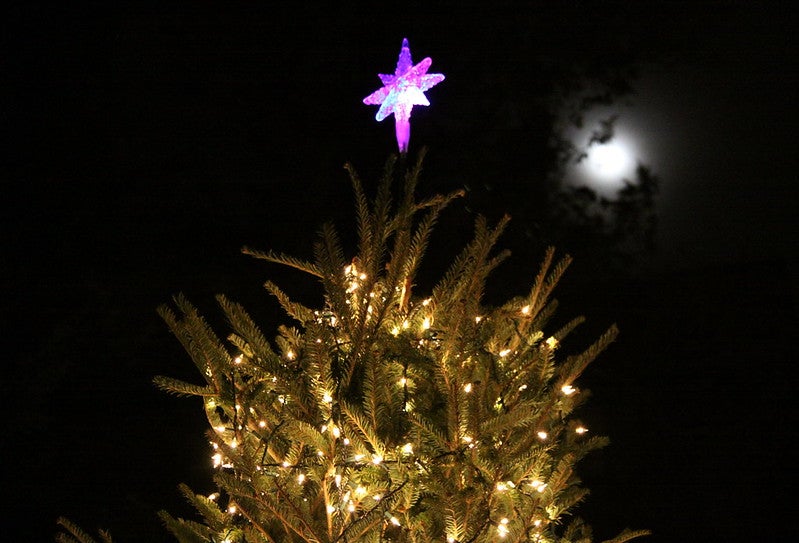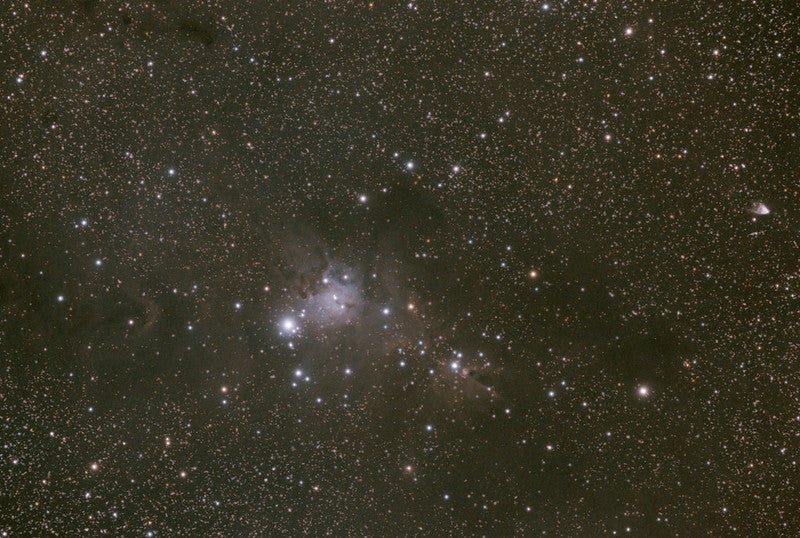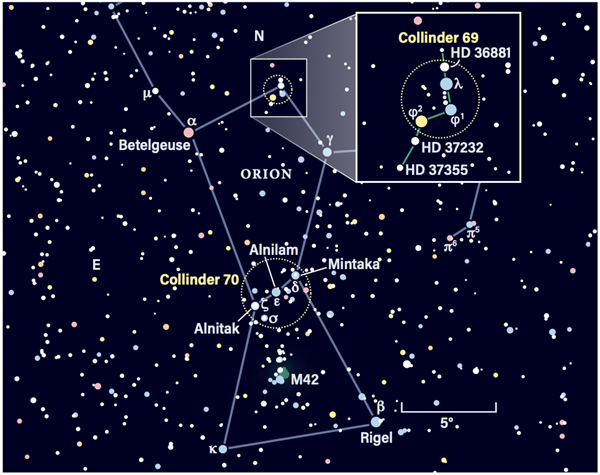
Friday, December 22
The Moon passes 3° north of Jupiter at 9 A.M. EST. Shortly after sunset, you can find both high in the east, in Aries. The Moon is now nearly 7° northeast (to the left) of Jupiter, hanging directly below the Ram’s brightest star, magnitude 2 Hamal. Jupiter is a blazing magnitude –2.7, the brightest object in the sky after an 83-percent-lit Luna beside it. Both sit to the right of the Pleiades star cluster, which may be visible as either a smudge or a tightly knit group of stars, depending on your sky conditions.
Through a telescope, you may be able to catch Jupiter’s Galilean moon Io transiting the planet’s face. The event starts shortly before sunset on the East Coast and is well underway as the Sun disappears in the Midwest. At 6 P.M. EST, the moon’s shadow finally slips onto the cloud tops, with Io roughly halfway through its transit. Both are moving from east to west. Io exits the disk shortly after 7 P.M. EST; its shadow is halfway across at that time and takes a little over an hour to finish its own journey. Io joins Callisto on the west side of Jupiter, while Ganymede (closer) and Europa remain to the planet’s east.
Also today, Mercury reaches inferior conjunction with the Sun at 2 P.M. EST and main-belt asteroid 9 Metis is at opposition at 6 P.M. EST.
Sunrise: 7:19 A.M.
Sunset: 4:38 P.M.
Moonrise: 1:27 P.M.
Moonset: 2:46 A.M.
Moon Phase: Waxing gibbous (81%)
*Times for sunrise, sunset, moonrise, and moonset are given in local time from 40° N 90° W. The Moon’s illumination is given at 12 P.M. local time from the same location.
Saturday, December 23
Just a day after passing Jupiter, the Moon passes 3° north of Uranus — also in Aries — at 10 A.M. EST. By evening, the Moon has moved on and straddles the border of Aries and Taurus, sitting almost perfectly halfway between the ice giant and the Pleiades.
Uranus, at magnitude 5.7, is just at the edge of naked-eye visibility from a dark site. But with the bright Moon nearby, even those with good skies would do best to pull out binoculars or a telescope to find it. The planet lies some 2.6° south-southwest of 4th-magnitude Delta (δ) Arietis, also called Botein. Now nearly 19 AU from Earth, Uranus spans just 4″ on the sky and appears as a grayish, “flat”-looking star. (One AU, or astronomical unit, is the average Earth-Sun distance of 93 million miles [150 million kilometers]).
While you’ve got your optics out, swing over to the other side of the Moon to visit the Pleiades (M45). This nearby open cluster is best viewed with binoculars or a very low-powered scope — you can even use your finder scope to gather more stars, as they’re bright and appear spread across some 110′ of sky.
Sunrise: 7:19 A.M.
Sunset: 4:39 P.M.
Moonrise: 1:57 P.M.
Moonset: 3:58 A.M.
Moon Phase: Waxing gibbous (89%)
Sunday, December 24
Swing over to Saturn this evening, already starting to set in the south an hour after sunset. The planet glows softly at magnitude 0.9, still the brightest object in its immediate vicinity. To Saturn’s lower left lies the 1st-magitnude star Fomalhaut in Piscis Austrinus; farther to the planet’s lower right is brighter Altair in Aquila the Eagle.
Dedicated observers can watch as Saturn’s moon Tethys undergoes a transit this evening. The event is best caught by high-speed video, as the contrast between the moon and planet is not particularly high, presenting a challenge for following it visually. Tethys begins crossing the southern regions of Saturn’s disk at 8:27 P.M. EST, moving from east to west. The small moon takes 108 minutes to complete its transit before slipping away to hang beneath the rings on Saturn’s eastern side.
If this observation is too challenging, look for much brighter Titan, Saturn’s largest moon. It’s around 8th magnitude and tonight lies just over 2.5′ due west of the ringed planet. It should be much easier to pick up and can easily be mistaken for a field star when its separation is this large!
Sunrise: 7:20 A.M.
Sunset: 4:39 P.M.
Moonrise: 2:33 P.M.
Moonset: 5:09 A.M.
Moon Phase: Waxing gibbous (94%)

Monday, December 25
Following Orion up into the eastern sky is the constellation Monoceros the Unicorn. Here is where we’ll find NGC 2264, also known as the Christmas Tree Cluster for its shape, akin to that of a triangular pine tree.
There’s a lot packed into this target. Although at magnitude 3.9 it’s visible as a fuzzy patch of light to the naked eye, the nearby Moon will hinder us a bit in that area. Instead, binoculars or any telescope will show the star cluster, located just 3.2° south of 3rd-magnitude Xi (ξ) Geminorum and centered around 5th-magnitude 15 Monocerotis, the bright star that sits at the base of the Christmas Tree’s trunk. The tree itself is pointing south and stretches about ¼° from base to tip. Magnifications of 50x or greater should show it.
Just off that tip is a dark “trunk” of dust that observers with the largest scopes (or astrophotographers) might see — this is the Cone Nebula.
Sunrise: 7:20 A.M.
Sunset: 4:40 P.M.
Moonrise: 3:18 P.M.
Moonset: 6:18 A.M.
Moon Phase: Waxing gibbous (98%)
Tuesday, December 26
Full Moon occurs at 7:33 P.M. EST, gracing us with December’s Cold Moon. Our satellite is now at the border between southwestern Gemini and southeastern Auriga, hanging about 13.5° below the latter constellation’s brightest star, magnitude 0.1 Capella. After dark this star is high in the east. It is the closest bright star to the North Celestial Pole, marked by much fainter Polaris at the end of the Little Dipper’s handle.
Just over 4° southwest of Capella is a triangle of stars called The Kids, so named because Capella itself means “She-Goat.” These are (clockwise from the northernmost star) magnitude 3 Almaaz (Epsilon [ϵ] Aurigae), magnitude 3.7 Haedus I (Zeta [ζ] Aurigae), and magnitude 3.2 Haedus II (Eta [η] Aurigae).
Slowly setting in the southwest later in the evening is still-bright Jupiter, now just a touch fainter at magnitude –2.6. Its moons are busy tonight: Earlier in the evening, Ganymede is visible near the planet’s northwestern limb, approaching fast. The large moon disappears behind Jupiter’s north polar regions around 10:20 P.M. EST, taking just under two hours to reappear (shortly after midnight EST).
Meanwhile, Europa is approaching from the east; the icy moon begins a transit around 1:30 A.M. EST (early morning on the 27th for Eastern and Central time zones, still late on the 26th farther west) and takes about 2 hours and 15 minutes to cross. Only observers in western time zones will be able to see the moon slip away from the planet’s disk before it sets.
As Europa crosses, Io is approaching from the west — it disappears in its own occultation just after 2 A.M. CST. By this time, Jupiter has set on the East Coast.
Callisto stays out of the action tonight, floating far to Jupiter’s east.
Sunrise: 7:21 A.M.
Sunset: 4:41 P.M.
Moonrise: 4:10 P.M.
Moonset: 7:22 A.M.
Moon Phase: Full
Wednesday, December 27
Following in Metis’ footsteps from earlier this week, asteroid 5 Astraea reaches opposition at 5 P.M. EST. This main-belt world is also near the feet of Gemini and, at magnitude 9.4, about a magnitude fainter than Metis. You’ll find Astraea just 3.5° due west of magnitude 1.9 Alhena, cataloged as Gamma (γ) Gem.
Turn back to bright Jupiter in Aries later tonight and you can catch another transit of Io, as well as a look at the planet’s huge, stormy Great Red Spot. This Earth-sized tempest should be crossing the midpoint of Jupiter’s face around 11:45 P.M. EST, becoming visible roughly two hours before this time and remaining visible for roughly two hours after it as the planet rapidly rotates. Meanwhile, Io is approaching again from the east; the small moon will cross onto the cloud tops around 11:15 P.M. EST, taking just over two hours to cross Jupiter’s large face. Its shadow finally appears around 12:30 A.M. EST (on the 28th in the Eastern time zone; late on the 27th for those farther west), trailing it across the planet in another just-over-two-hour transit.
Sunrise: 7:21 A.M.
Sunset: 4:41 P.M.
Moonrise: 5:10 P.M.
Moonset: 8:16 A.M.
Moon Phase: Waning gibbous (99%)
Thursday, December 28
Let’s return to Saturn to see how the moon Titan has moved from far west to north of the ringed world. Titan’s orbital period is just under 16 days; the bright, 8th-magnitude moon now sits just 37″ northwest of Saturn.
The eastern half of the country might also spot tiny Mimas and its shadow transiting the planet’s southern regions early in the evening, following in Tethys’ immediate footsteps. As the Sun is setting on the East Coast, Tethys is nearly finished with a transit, ready to slip off the southwestern portion of the disk. Its shadow follows, disappearing around 5:45 P.M. EST, around sunset in the Midwest. Meanwhile, Mimas starts its transit around 4:55 P.M. EST, its shadow appearing less than 10 minutes later. Again, these events are best caught on camera, as the small moons will be hard to see against the brighter cloud tops.
At the same time, Dione is sliding beneath the planet’s south pole without passing in front of it, though this moon’s shadow does fall on the cloud tops, crossing the southern polar regions from about 7:15 P.M. to 9 P.M. EST, shortly before the planet sets on the East Coast but while it is still more easily visible farther west.
Sunrise: 7:21 A.M.
Sunset: 4:42 P.M.
Moonrise: 6:13 P.M.
Moonset: 9:01 A.M.
Moon Phase: Waning gibbous (97%)

Friday, December 29
You may be familiar with Orion’s Belt, but do you know about the star cluster that surrounds it? Collinder 70 is sometimes called the Belt Cluster because its roughly 100 stars surround the region of the three Belt stars, called Alnitak, Alnilam, and Mintaka. Under dark skies you can spot a slight increase in the number of stars in the area with the naked eye. Binoculars will bring out some 70 of these suns, and a wide-field telescopic view will show even more.
A second Collinder cluster — Collinder 69 — also resides in the Hunter. Look up to Orion’s head, Lambda (λ) Orionis, with binoculars to see some two dozen stars surrounding it, covering an area about 70′ in diameter. There’s also a nebula in this region — Sharpless 2–264 — that’s a real challenge to see, but can be spotted with sharp eyes under extremely dark skies. Alternatively, the nebula shows up well in astroimages.
Sunrise: 7:22 A.M.
Sunset: 4:43 P.M.
Moonrise: 7:17 P.M.
Moonset: 9:38 A.M.
Moon Phase: Waning gibbous (93%)

Sky This Week is brought to you in part by Celestron.









